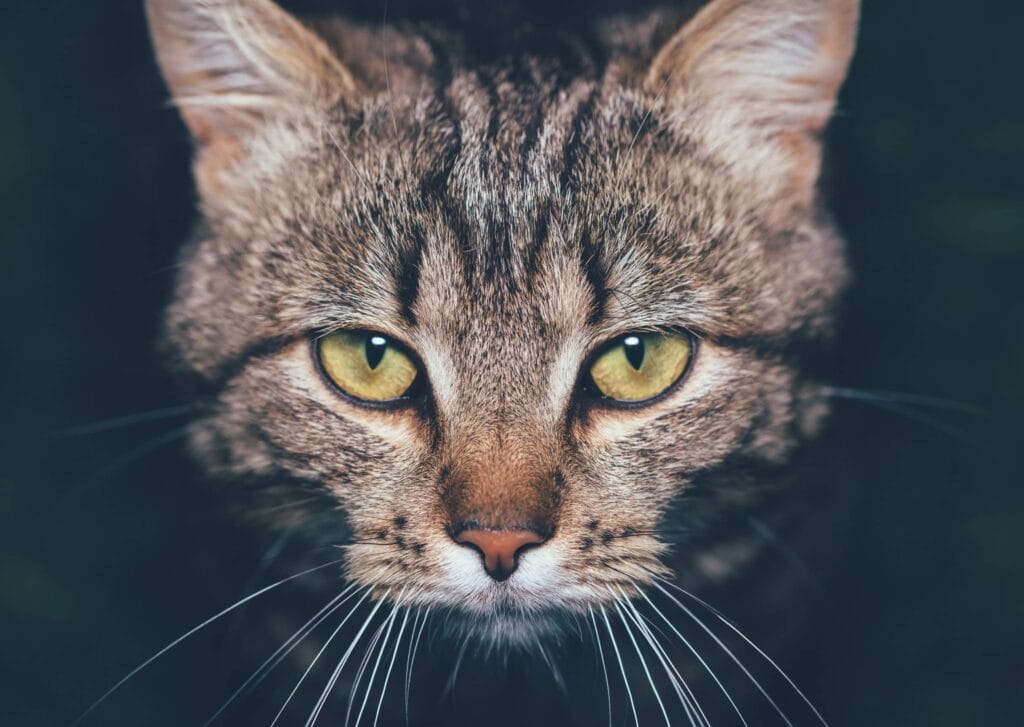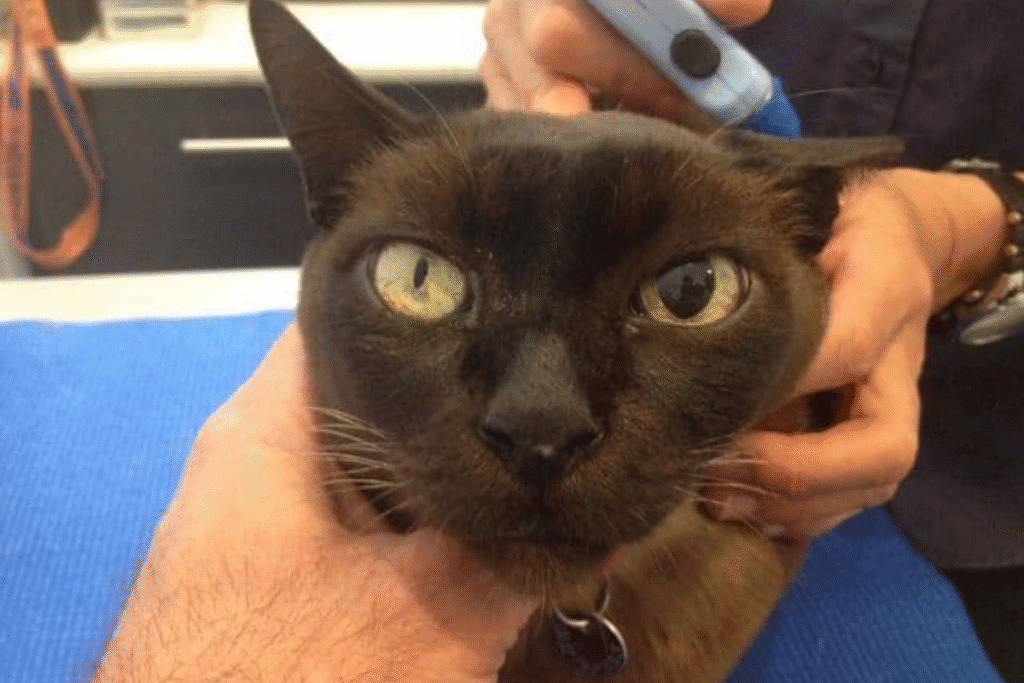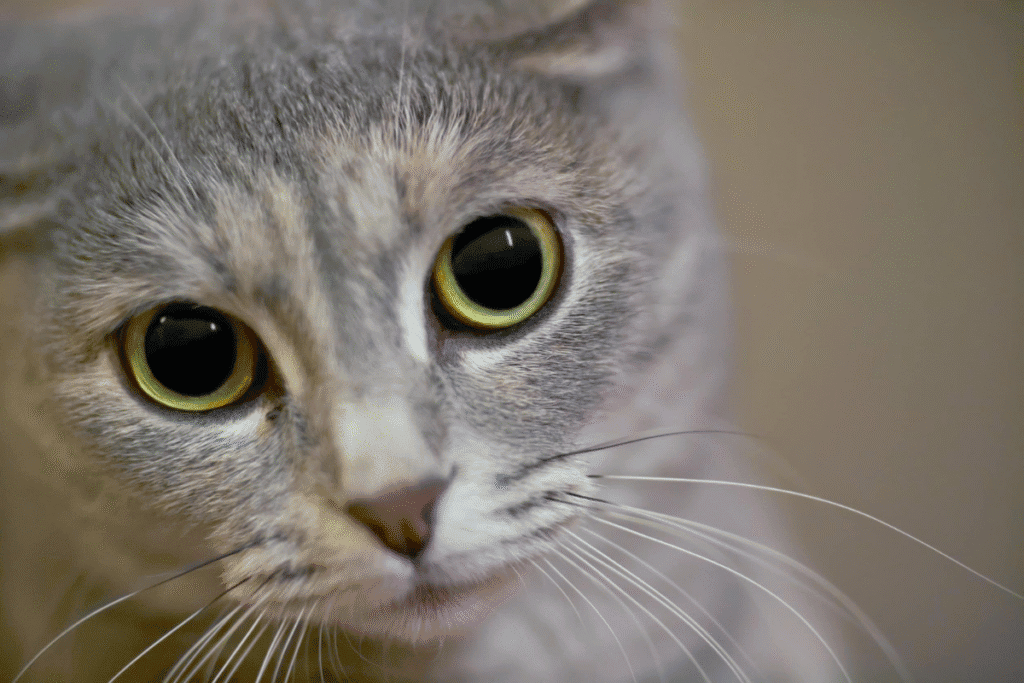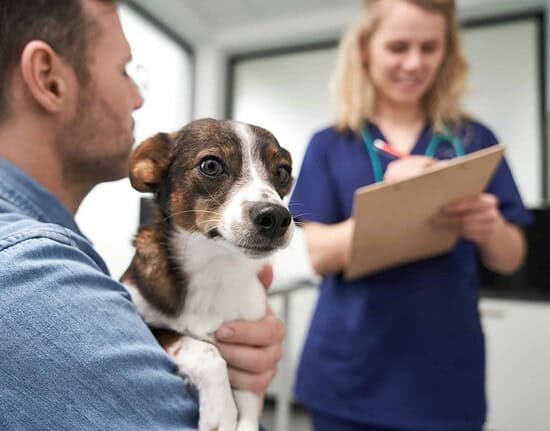Last updated on August 30th, 2025 at 01:42 am
Ever notice your cat staring at you with huge, wide eyes—and wondered if something’s wrong?
As a veterinarian, I’ve seen everything from playful kittens with cartoon-like pupils to senior cats whose dilated eyes were the first clue something serious was going on.
One of my patients, a calm older tabby, came in with unusually large pupils—and it turned out to be high blood pressure from kidney disease.
Sometimes, those big eyes are totally harmless. Other times, they’re your cat’s way of saying, “Hey, something’s off.”
Let’s talk about what dilated pupils in cats really mean—and when it’s time to worry.
Normal Cat Pupils
Cats’ pupils change in size and shape in response to light and emotion. Typically, their pupils are vertical slits, indicating they are content and relaxed. However, when a cat is excited and ready to pounce, their pupils become round and large.
What Causes Dilated Cat Eyes?
There are a few common reasons why your cat’s pupils might look super wide. Some are totally normal. Others might mean something’s bothering them. Here’s what to watch for:
Low Light
This is the most common reason. When it’s dark, your cat’s pupils get bigger to let in more light—just like ours do. It helps them see better, especially at night.
Excitement or Play Mode
When cats get the zoomies or lock eyes on a toy, their pupils often get huge. It’s just their body reacting to all the excitement and movement.
Fear or Stress
Scared cats go into “fight or flight” mode. Their pupils get big so they can take in more of what’s going on around them. You might notice this at the vet, during fireworks, or when something startles them.
Pain or Not Feeling Well
Big eyes can also be a sign that your cat is hurting. If they’re hiding, meowing more than usual, or acting off and their pupils are wide, it’s worth getting them checked out.
@jordieollie Black hole setting activated ✅ Which means it’s time for some chaos 😝 #catsoftiktok #tabbycat #tabby #blackholesetting #cateyes #catbigeyes #walterthecat ♬ original sound – ✨Walter the Catt✨
TikTok user @jordieollie jokingly describes the reasone for her cat's dilated pupils.
Medical Conditions That Cause Dilated Pupils
Sometimes, dilated pupils aren’t just about mood or lighting—they can be a sign of something deeper going on with your cat’s health. Here are the medical conditions that may cause pupils to stay wide:
Hypertension – High blood pressure (hypertension) can cause dilated pupils and symptoms such as weight loss, appetite changes, dull haircoat and, blindness in some cases. I usually see cats that have high blood pressure secondary to kidney disease.
Retinal detachment – This can happen when the thin layer of tissue at the back of your cat’s eye (called the retina) pulls away from its normal position. Since the retina is what helps your cat see, detachment can lead to sudden vision loss—and often causes the pupils to stay wide. This is especially common in older cats with high blood pressure.
Uveitis – Inflammation inside the eye that may cause one or both pupils to appear dilated, uneven, or slow to respond to light—and often comes with redness, squinting, or eye discharge.
Head Trauma – This type of injury in cats can affect the nerves that control the eyes, leading to one or both pupils becoming dilated. This may be a sign of brain swelling or nerve damage and should be treated as a medical emergency.
Vet Note
When I worked in emergency, a cat came in late one night after falling from a second-story window. He was quiet, dazed, and his pupils were both completely dilated. That was one of the first signs that told me we might be dealing with head trauma. We stabilized him and monitored his neurological signs closely overnight. Thankfully, he pulled through—but his eyes gave us the first clue that something serious was going on.
Progressive Retinal Atrophy (PRA) – Cells that make up the retina start to die, which can lead to blindness and dilated pupils.
Glaucoma – Increased intraocular pressure results in wide pupils. It can affect one or both eyes and requires immediate veterinary attention.
Iris Atrophy – Thinning of the iris that appears as if there are holes in the iris structure. Usually, it affects only one eye (unilateral).
Ocular and Brain tumors – Tumors affecting the eye structures or brain can trigger wide pupils. Based on the type of tumor, other signs are chronic pain, third eyelid changes, cat eye discharge, and cloudy eyes.
Poor Vision – With age and other underlying conditions, a cat’s vision can deteriorate, leading to dilated pupils. A cat with poor vision is likely to squint a lot.
Feline Dysautonomia – A neurological condition that affects the autonomic nervous system and results in dilated pupils and respiratory symptoms.
Anisocoria – When the cat has uneven pupils or where one pupil is more dilated than the other. Anisocoria can be the result of corneal ulcers and glaucoma.
When to Call the Vet About Dilated Cat Eyes
It’s totally normal for your cat’s pupils to get big in dim light or when they’re excited. But if their eyes stay wide for too long—or if something else seems off—it’s a good idea to check in with your vet.
These are specific situations when you should make that call:
Pupils Stay Dilated in Bright Light
If your cat’s eyes don’t adjust back to normal size, especially in well-lit spaces, it could point to a health issue.
You notice other symptoms like low energy, vomiting, appetite changes, weird behavior, or signs of pain. When wide pupils come with any of these, don’t wait.
Eyes Look Unusual
Cloudiness, discharge, redness, swelling, or squinting are all signs something’s not right.
Your Cat Is a Senior (older than 7 years)
Older cats are more likely to have underlying conditions—like high blood pressure or eye problems—that can affect pupil size. Routine checkups are a must.
What Will Happen At The Vet
Your veterinarian will perform a complete exam and order some testing to find out the underlying cause of your cat’s dilated eyes. This includes:
- Baseline tests (bloodwork, urinalysis, blood pressure, etc.)
- Ophthalmoscopy, to examine the retina, optic nerve, and blood vessels.
- Tonometry, to measure the pressure inside the eye for glaucoma.
- Ultrasound, to evaluate the eyes.
- CT scan, to evaluate for brain tumors.
How Are Dilated Pupils in Cats Treated?
Treatment really depends on what’s causing the dilation in the first place. Dilated pupils aren’t a diagnosis—they’re a sign that something else might be going on. Here’s how vets typically handle it:
If it’s caused by pain-
Your vet may prescribe pain medication or treat the underlying condition (like dental disease, injury, or arthritis).
If it’s high blood pressure-
This is common in older cats. Your vet will likely start your cat on blood pressure medication (like Amlodipine) and monitor their progress over time.
If it’s an eye problem (like glaucoma or uveitis)-
Medicated eye drops, anti-inflammatory eye drops, or other specific treatments may be needed. In some cases, your cat may need to see a veterinary ophthalmologist.
If it’s due to vision loss or PRA (Progressive Retinal Atrophy)-
There’s no cure for PRA, but your vet can help you support your cat’s quality of life as their vision changes.
If it’s something serious like a brain tumor or neurological issue-
Further testing like imaging (MRI/CT) may be needed. Treatment depends on what’s found and how advanced it is.
A Rare Case – Dental Work and Sudden Blindness
Most of the time, dilated pupils are nothing serious. But a recent case report shared a surprising situation: a cat went blind in both eyes just a few days after a routine dental cleaning. Thankfully, some vision returned over the next few weeks.
The veterinarians believed that keeping the cat’s mouth open wide for an extended time during the dental may have briefly affected blood flow to the eyes, causing temporary damage.
Takeaway for pet parents 👉 While this is very rare, it’s a good reminder to keep an eye on your cat after any procedure. If you notice sudden changes in vision or pupil size, contact your vet right away.
Vision Loss
When a cat starts to lose its vision, its eyes naturally dilate as they attempt to capture more light for visibility. If you observe abnormal behavior and notice any of these signs, your cat might be blind or on the verge of losing its sight.
Signs of vision loss in cats:
- Hesitation to jump or climb
- Squinting
- Redness surrounding the eyes
- Eyes appearing milky or cloudy
- Displaying unsteadiness while walking
- Struggling to locate water
- Walking with whiskers close to the ground
- Easily startled by sudden noises
- Excessive vocalization, indicating distress
Ways To Check Your Cat’s Vision
- You can easily assess your cat’s vision with these straightforward methods:
- Swiftly move a laser pointer across the floor in front of your cat.
- Toss cotton balls in their path; cats typically engage with them.
- Gently wave your hand towards your cat’s eyes (without creating a breeze). Their natural response should be to blink.
- Direct a bright light into their eyes; they should react accordingly.
How To Help A Blind Cat
In the event of your cat experiencing permanent blindness, there are steps you can take to assist:
- Maintain the arrangement of furniture as your cat is accustomed to.
- Communicate with your cat frequently in a calming manner.
- Refrain from surprising your cat; announce your presence.
- Ensure there are no obstacles obstructing your cat’s path.
- Minimize exposure to loud noises to prevent distress.
Final Note – Dilated Cat Eyes
Cats can have wide eyes for all kinds of reasons—sometimes it’s just part of playtime, excitement, or even catnip zoomies. Other times, it’s their way of telling you something’s off. If your cat’s pupils go back to normal and they’re acting like their usual self, there’s probably no need to worry.
But if the dilation sticks around, or you notice other changes in their behavior or health, don’t wait. Give your vet a call. Even a quick conversation can give you peace of mind—or help you catch something early.
Cats with vision issues can still live full, happy lives. The key is paying attention and getting support when you need it. You know your cat best—so if something feels off, trust your gut and reach out.
Frequently Asked Questions (FAQs)
Why are my cat’s eyes always dilated?
If your cat’s pupils are constantly wide—even in bright light—it could be a sign of an underlying issue like high blood pressure, vision loss, or a neurological problem like a brain tumor. It’s worth getting them checked by your vet, especially if you notice other changes in behavior or health.
Is it normal for older cats to have dilated pupils?
Sometimes. Older cats are more prone to health conditions that can affect the eyes, like high blood pressure, iris atrophy, or retinal degeneration. But dilated pupils all the time shouldn’t be ignored—your vet can help determine if it’s age-related or something more serious.
How do you treat dilated pupils in cats?
Treatment depends on the cause. If it’s due to high blood pressure, medications (like Amlodipine) can help. If it’s an eye condition like glaucoma, more specific treatments like medicated eye drops or even surgery might be needed.
What’s the difference between normal and not-normal dilation?
Normal: Pupils get big in the dark, during play, or when your cat is excited or scared.
Not-normal: Pupils stay big all the time, don’t shrink in bright light, or your cat acts sick (like not eating and being lethargic).
My cat’s eyes are big and they’re purring. Should I worry?
Probably not! Purring and wide eyes often go together when your cat is happy or playful. But if they also seem sick, confused, or in pain, get them checked out.
What does it mean when my cat squints or half-closes their eyes?
Squinted or sleepy-looking eyes are usually a good sign! It means your cat feels safe, relaxed, and trusts you. If they look like they’re about to nod off—it’s because they probably are. This soft eye expression is sometimes called a “cat kiss.” You can try slowly blinking back to say, “I love you” in cat language.
References
Cullen CL, Grahn BH. Anisocoria in cats: A practical diagnostic approach. J Feline Med Surg. 2019;21(5):413–424. https://doi.org/10.1177/1098612X18818668
Related Posts | More Cat Tips & Guides You’ll Love
What Colors Can Cats See? – Find out how cats see colors in their environment.
The Best Cat Apps for Your Phone — From entertainment to health tracking, check out these must-have apps for cat lovers.
Cat Coughing or Sneezing? Here’s What You Can Do — Home care tips and signs it’s time to see your vet.
Create a SHTF Bug Out Bag for Your Cat — Be ready for emergencies with this cat-specific prepper checklist.




















Leave feedback about this